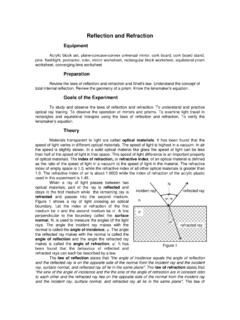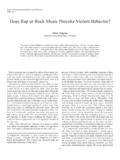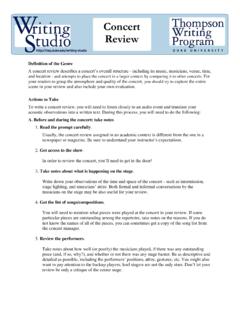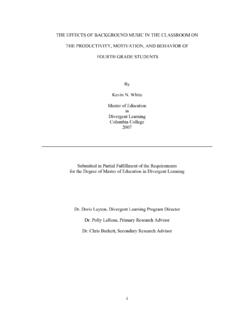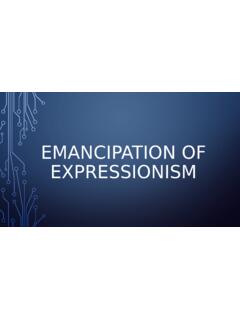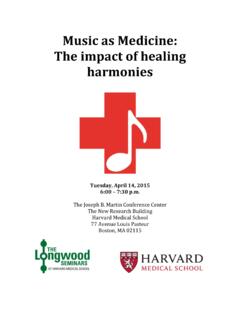Transcription of AN INTRODUCTION TO THE CLASSICAL MUSIC OF INDIA
1 AN INTRODUCTION TO THE CLASSICAL MUSIC OF INDIADR angaraj M. Rangayyanepartment of Electrical and Computer EngineeringCUniversity of Calgaryalgary, Canada T2N : +1 (403) 220-6745 Fax: +1 (403) 282-6855aWe-mail: ranga@ Scandia Hill , Alberta, CANADA T3L 1T8 Phone/fax: +1 (403) 239-7380I. INTRODUCTIONsrIndian CLASSICAL MUSIC is one of the oldest forms of MUSIC in the world. It has itoots in diverse areas such as the ancient religiousvedichymns, tribal chants,odevotional temple MUSIC , and folk MUSIC [2]. Indian MUSIC is melodic in nature, aspposed to Western MUSIC which is harmonic. The most important point to note isspthat movements in Indian CLASSICAL MUSIC are on a one-note-at-a-time basis.
2 Thirogression of sound patterns along time is the most significant contributor to the tunesnand rhythm of the presentation, and hence to the melody[2]. Although Indian MUSIC iow divided into the two major classes ofHindusthani(Northern Indian) andKarnataketorCarnatic(Southern Indian), the origins and fundamental concepts of both thesypes of MUSIC are the same. The form of presentation may however vary between thetwo systems, as well as from onegharana(family) to another in the former fundamental concepts that have to be understood at the outset are those offtswara(musical note),raga(a melodic concept, or scale of notes) andtala(beats oiming or rhythm). This paper begins with an INTRODUCTION to these ofraga-s and musical compositions in theHindusthanistyle are used tollustrate the important features of Indian MUSIC .
3 Most of the discussion, however,should be applicable to theKarnataksystem as well, and to Indian MUSIC in SWARA-S: THE MUSICAL NOTES nlike the case in Western MUSIC , the musical notes used in Indian MUSIC are notrat standardized frequencies. One may choose any frequency of convenience as theeference, and this frequency would then act as the tonic or base of reference for theumusic to be presented. Before entering the realm of theswara-s, we shouldnderstand the concept of THE OCTAVE:While it may be convenient at first sight to see the entire gamut of notes on anytsinstrument, for example the piano, as a sequential arrangement of different notes, ioon becomes apparent that there are notes that sound "similar", but are at differentifrequencies or pitches[2].
4 Pairs of such notes, where the frequency of the higher notes twice that of the lower note, define a range of notes called an octave. Such a higherrnote, and further notes that are at integral multiples of the frequency of the lower noteeferred to, are called the harmonics of the lower note. Thus the entire range of notesBavailable may be seen as a cyclical arrangement of MICRONOTES AND NOTES:It has been observed, by ancient Indian musicians as well as more recentdmusicians and musicologists across the world, that the human ear is capable ofistinguishing at the most 22 musically different or significant notes within any givenecoctave. These notes are referred to as micronotes, of these notes aronsidered to be the basic notes orswara-s in Indian CLASSICAL MUSIC .
5 For this reason,(an octave is called asaptak,meaning a group of seven notes. The basic reference note4the tonic) is calledshadja(abbreviated assain singing and writing, asShere).cWhile this could be at any frequency, let us consider it to be at 240 Hz (Hertz =ycles per second) for the sake of illustration and further discussion. The octaveHspanning 240-480 Hz is then themadhya saptakor middle octave, the range 120-240z is the lower octave ormandra saptak,and the frequencies 480-960 Hz make up thertaar saptakor higher octave. The remaining notes in an octave are defined witheference to S, and are calledrishabh (ri or ray, R), gandhaar (ga, G), madhyam (ma,aM), pancham (pa, P), dhaivat (dha, D),andnishad (ni, N).
6 (These notes correspondpproximately to the notesC,D,E,F,G,AandBin the Western MUSIC scale.) ThesSnext note would be the first note of the next octave, ashadjaagain, which is written a., and the same sequence repeats for the higher notes. The rangesS MandP the lower and upper tetrachords of the middle octave. The same pattern repeator the lower octave as well, with the notes written as, , WithSat 240 Hz, theHnominal frequencies ofR,G,M,P,DandNare 270, 300, 320, 360, 405 and 450z in theshuddhaor pure scale of Indian MUSIC [3]. It is readily seen that thesesgfrequencies do not bear an additive relationship. The progression of notes ieometric, being related by the fifth, ,P/S=D/R=N/G= [3].
7 Insbterms of the micronotes, the difference or spacing between the above basic notes varieetween two, three, and four [1]. These basic notes are called theshuddha swara-s,,pmeaning pure notes. Of these notes,S, on account of its being the tonic, andPerhaps to serve as a secondary reference at the middle of an octave, are considered toebe immobile, orachala swara-s. Five additional notes are obtained by altering th5iremaining five basic notes as follows. The notesR,G,D, andNare lowered slightlyn frequency (by one or two micronotes) to get their flat orkomalversions, written asoR ,G ,D , andN . The noteM, however, is moved to a slightly higher frequency tobtain its sharp orteevravariant, written asM.
8 With the altered orvikrit swara-sincluded, an octave now has twelve notes as follows:SR RG GMM PD DN N.:C. THE IMPORTANCE OF THE TONIC AND THE DRONEWith the notes defined as above, the importance of the tonicScannot besaunderstated. The tonic is, simply stated, the basis of the MUSIC . All the musical notere defined with respect to the chosenS. A musician has to continuously refer to the,aSto create the other notes, and to remain in tune orshruti(in the case of vocal musicnd instruments without frets or keys for all the notes). In fact, the first exercise givenesa student is to sing repeatedly the notesS,P,S., in order to establish also the state of rest, which if not provided often could lead to a state ofmunrest, unease, or confusion[2].
9 While there can be noragawithout theshadjaasay be readily seen from the above discussion, it is sparingly used on purpose in theearaga Marvato create the feeling of unrest to bring out the corresponding mood of latfternoon, at which time it is to be continuous tonic required by an Indian musician is provided by a variety oftinstruments. The most commonly used drone, as such an instrument is called, is is a stringed instrument, with four or five long strings on anaunfretted board, ending in a large resonating chamber hollowed out of wood ( as an additionaSrgourd shell. The strings are tuned toP.,S,S, andeference at the middle of the octave, although the be usedasometimes instead of ) The strings are plucked cyclically one at a time in a slownd steady pace.
10 The contacts of the strings with the bridge are tempered withspthreads, which lends to the creation of a unique set of harmonics of each of the noteroduced by the strings. Additional notes are also generated by the combination of thebbasic notes produced by the strings. This effect, coupled with the resonance createdy the chamber, gives the sound of the instrument a quality its own. The instrumentralso lends a good sustenance to the sounds, and thus the musician is immersed in theequired tonic reference sounds. By referring to these sounds, the musician may deriveother notes by either consonance or drones, calledshruti petti(box of notes), are also available, whereetbellows are used to force air through one or more reeds at the same notes as in this case, however, all the notes are produced together, and hence mergeoto create a different effect.


